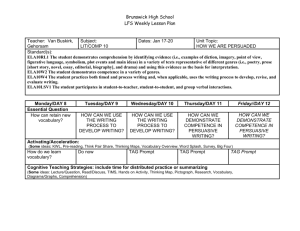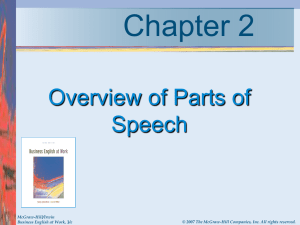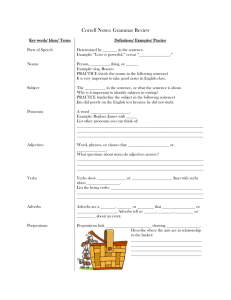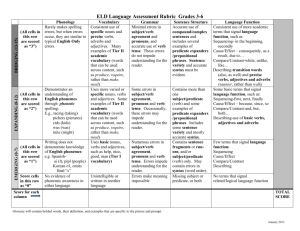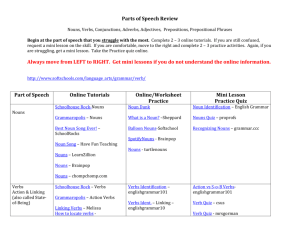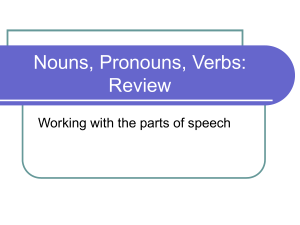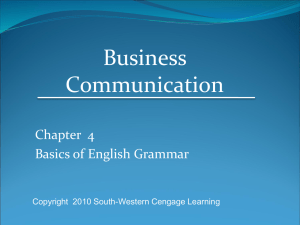parts of speech basics for end-of
advertisement
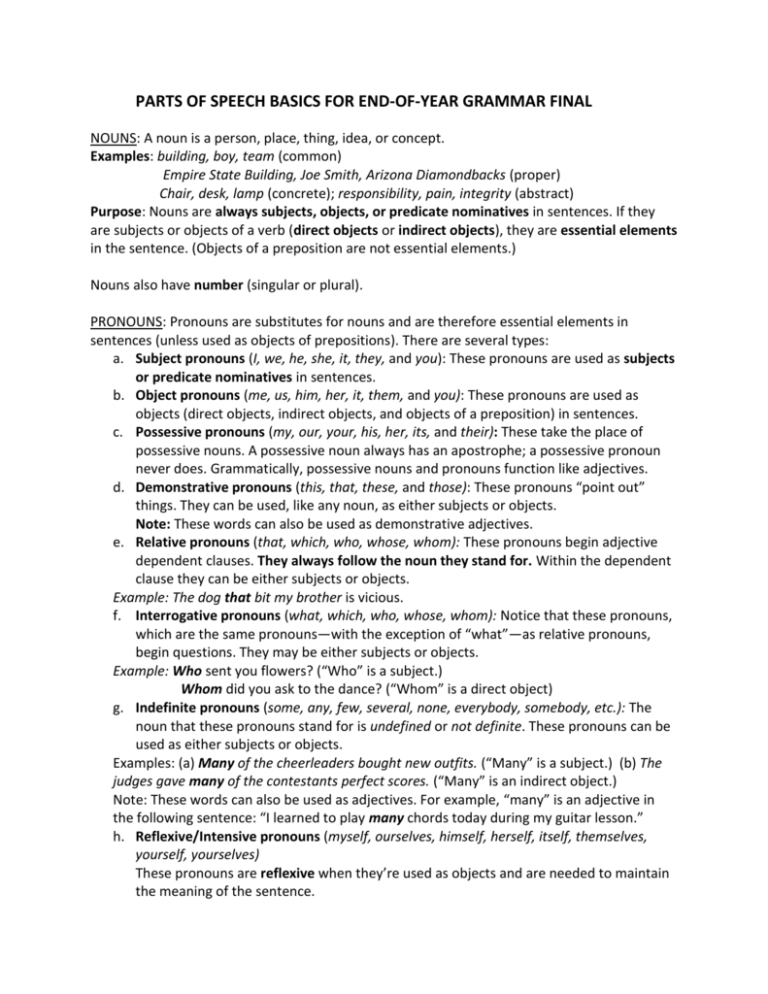
PARTS OF SPEECH BASICS FOR END-OF-YEAR GRAMMAR FINAL NOUNS: A noun is a person, place, thing, idea, or concept. Examples: building, boy, team (common) Empire State Building, Joe Smith, Arizona Diamondbacks (proper) Chair, desk, lamp (concrete); responsibility, pain, integrity (abstract) Purpose: Nouns are always subjects, objects, or predicate nominatives in sentences. If they are subjects or objects of a verb (direct objects or indirect objects), they are essential elements in the sentence. (Objects of a preposition are not essential elements.) Nouns also have number (singular or plural). PRONOUNS: Pronouns are substitutes for nouns and are therefore essential elements in sentences (unless used as objects of prepositions). There are several types: a. Subject pronouns (I, we, he, she, it, they, and you): These pronouns are used as subjects or predicate nominatives in sentences. b. Object pronouns (me, us, him, her, it, them, and you): These pronouns are used as objects (direct objects, indirect objects, and objects of a preposition) in sentences. c. Possessive pronouns (my, our, your, his, her, its, and their): These take the place of possessive nouns. A possessive noun always has an apostrophe; a possessive pronoun never does. Grammatically, possessive nouns and pronouns function like adjectives. d. Demonstrative pronouns (this, that, these, and those): These pronouns “point out” things. They can be used, like any noun, as either subjects or objects. Note: These words can also be used as demonstrative adjectives. e. Relative pronouns (that, which, who, whose, whom): These pronouns begin adjective dependent clauses. They always follow the noun they stand for. Within the dependent clause they can be either subjects or objects. Example: The dog that bit my brother is vicious. f. Interrogative pronouns (what, which, who, whose, whom): Notice that these pronouns, which are the same pronouns—with the exception of “what”—as relative pronouns, begin questions. They may be either subjects or objects. Example: Who sent you flowers? (“Who” is a subject.) Whom did you ask to the dance? (“Whom” is a direct object) g. Indefinite pronouns (some, any, few, several, none, everybody, somebody, etc.): The noun that these pronouns stand for is undefined or not definite. These pronouns can be used as either subjects or objects. Examples: (a) Many of the cheerleaders bought new outfits. (“Many” is a subject.) (b) The judges gave many of the contestants perfect scores. (“Many” is an indirect object.) Note: These words can also be used as adjectives. For example, “many” is an adjective in the following sentence: “I learned to play many chords today during my guitar lesson.” h. Reflexive/Intensive pronouns (myself, ourselves, himself, herself, itself, themselves, yourself, yourselves) These pronouns are reflexive when they’re used as objects and are needed to maintain the meaning of the sentence. Example: “I bought myself a new coat.” In this sentence, “myself” is an indirect object; if it is taken out, the sentence doesn’t have the same meaning. These pronouns are intensive when they add emphasis but aren’t necessary to maintain the meaning of the sentence. Example: “I made the brownies myself.” VERBS a. Helping verbs (sometimes called auxiliary verbs): These verbs simply change the tense of the main verb, which must be an action verb or a linking verb. Helping verbs are always paired with other verbs. The most common helping verbs are the “be” verbs (is, am, are, was, were, be, been) and the “have” verbs (have, has, had). Other helping verbs include could, would, should, may, might, must, do, did, does, can, shall, and will. b. Linking verbs: These verbs express no action but instead express a “state of being.” A linking verb links or connects a word from the predicate back to the subject. This predicate word either identifies the subject and is a predicate nominative or describes the subject and is a predicate adjective. The most common linking verbs are the “be” verbs. Other common linking verbs are seem, feel, become, appear, smell, and grow. c. Intransitive verbs: These are action verbs that have no object. d. Transitive verbs: These action verbs have a direct object that receives their action; they may also have indirect objects. Note: Transitive, intransitive, and linking verbs are always essential elements in sentences. ADJECTIVES Adjectives are modifiers that describe nouns and pronouns. Adjectives always answer one of three questions about the noun(s) they modify: a. What kind(s)? (As in the sentence, “The skillful players were picked first.” b. Which one(s)? (As in the sentence, “I prefer the blue marbles.”) c. How many/much? (As in the sentence, “Several options were available.”) Note: Adjectives are only essential elements when they are predicate adjectives that follow a linking verb and describe the subject. Otherwise, adjectives are nonessential “window dressing” in sentences. ADVERBS Adverbs are versatile modifiers that modify the meaning of verbs, adjectives, or other adverbs. Adverbs answer several questions: a. When? (As in the sentence, “Yesterday I bought a new bike.”) b. Where? (As in the sentence, “I left my keys somewhere around here.”) c. How? (As in the sentence, “He plays piano skillfully.”) d. To what extent? (As in the sentence, “His injury is extremely painful.”) Notice that many adverbs end with an –ly suffix. e. Some adverbs also answer the question “Why?” but these are usually adverb phrases or adverb clauses and not single word adverbs. Note: Adverbs are never essential elements in sentences. If they are removed, the essential elements of the sentence remain intact. Adverbs are always nonessential “window dressing” in sentences. PREPOSITIONS Prepositions are words that usually denote position (above, below, on, in, beside, outside, inside, among, between), direction (in, out, from, toward), or time (before, after, during). Prepositions only exist if they have an object; without an object, a preposition is actually an adverb. Prepositions begin prepositional phrases, which, by definition, MUST contain a preposition and the object of that preposition; modifiers of the object may also be inside the prepositional phrase. The following examples include prepositional phrases (in bold font) and adverbs that are often used as prepositions: 1. 2. 3. 4. He walked up the dark street. I looked up and saw a bird streaking across the striated sky. The dog ran out the open door. The baserunner was called out at third base. CONJUNCTIONS The word conjunction joins the two Latin roots co- (with together) and jungere (to join). Grammatically, conjunctions do exactly what the roots declare: they join together like elements. These like elements may be single words, phrases, or even clauses. There are three main types of conjunctions: 1. Coordinating conjunctions. These single-word conjunctions combine like elements in sentences. You can remember the seven coordinating conjunctions by using the acronym FANBOYS: for, and, nor, but, or, yet, and so. 2. Correlative conjunctions. These conjunctions work in tandem, so all correlative conjunctions contain at least two words. Examples: neither … nor; either … or; both … and; not only … but also. 3. Subordinating conjunctions. These conjunctions combine an independent clause with a dependent clause. There is a long list of these types of conjunctions, which we will learn more about next year. Examples include the following: if, although, since, because, and after (when used with a clause, not a phrase). INTERJECTIONS These words express emotion, surprise, or passion, and have no other grammatical function; in other words, they are never part of the essential elements of a sentence. Examples include the following: Yowza! Wow! Supreme! Non-slack! Beauty!
